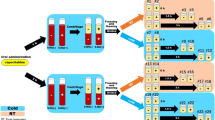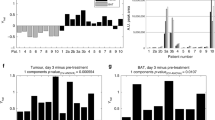Abstract
Chromogranin A (CgA) is present in high concentrations in enterochromaffin cells, where it is co-localised with serotonin in the storage granules. Plasma CgA has been reported to mark emesis and serotonin release associated with cisplatin treatment. However, it is not known whether plasma CgA could be an indicator of emesis and of serotonin release in patients receiving non-cisplatin chemotherapies. Therefore, in this study we evaluated, in cancer patients, the temporal relationships between the increases in plasma CgA and urinary 5-hydroxyindoleacetic acid (5-HIAA) and the development of vomiting following dacarbazine, nitrogen mustard and cyclophosphamide treatments. Metoclopramide was used as antiemetic. With dacarbazine, nitrogen mustard and cyclophosphamide the median time to the onset of emesis was 2.3, 2.8 and 5.3 h and the duration of intense emesis was 3, 2 and 6 h respectively. Plasma CgA and urinary 5-HIAA increased after dacarbazine- and nitrogen mustard-based chemotherapies, with maximal increases between 4 and 6 h after initiation of drug infusion. The time course for the increases in plasma CgA paralleled that of urinary 5-HIAA and the period of intense emesis. A highly significant (P = 0.0009) positive correlation (r = 0.68) was found between the increases in plasma CgA and in urinary 5-HIAA. Cyclophosphamide treatment was not associated with increases in plasma CgA and in urinary 5-HIAA, despite inducing emesis; this indicates that the increases in CgA and 5-HIAA after dacarbazine and nitrogen mustard are not due to the act of vomiting per se. In summary, plasma CgA is a marker of serotonin release (most likely from enterochromaffin cells) after dacarbazine and nitrogen mustard-based chemotherapies, exocytosis being the most likely mechanism for the release of serotonin. Serotonin released from enterochromaffin cells seems to trigger the emetic response to dacarbazine and nitrogen mustard; however, cyclophosphamide may release serotonin from a different pool (enteric serotonin neurons and/or CNS serotonin?).
This is a preview of subscription content, access via your institution
Access options
Subscribe to this journal
Receive 24 print issues and online access
$259.00 per year
only $10.79 per issue
Buy this article
- Purchase on Springer Link
- Instant access to full article PDF
Prices may be subject to local taxes which are calculated during checkout
Similar content being viewed by others
Author information
Authors and Affiliations
Rights and permissions
About this article
Cite this article
Cubeddu, L., O'Connor, D., Hoffmann, I. et al. Plasma chromogranin A marks emesis and serotonin release associated with dacarbazine and nitrogen mustard but not with cyclophosphamide-based chemotherapies. Br J Cancer 72, 1033–1038 (1995). https://doi.org/10.1038/bjc.1995.457
Issue Date:
DOI: https://doi.org/10.1038/bjc.1995.457
This article is cited by
-
Anti-emetic mechanisms of zingiber officinale against cisplatin induced emesis in the pigeon; behavioral and neurochemical correlates
BMC Complementary and Alternative Medicine (2015)
-
Anti-emetic efficacy of oral granisetron in the total control of late-onset emesis induced by cyclophosphamide-containing chemotherapy
Revista de Oncología (2004)
-
5-Hydroxyindoleacetic acid excretion following combination chemotherapy with cyclophosphamide, epirubicin and 5-fluorouracil plus ondansetron compared to ondansetron alone
Supportive Care in Cancer (1996)



